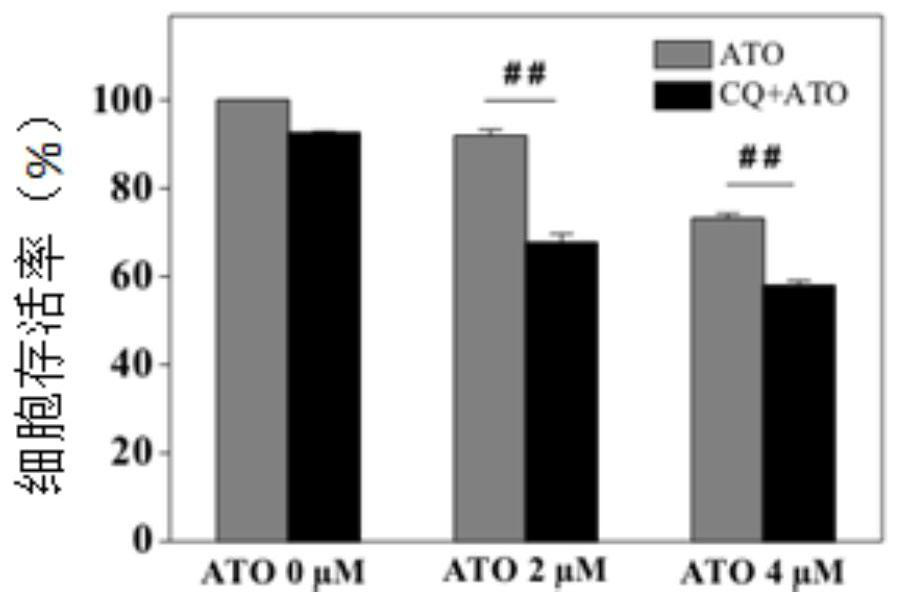A nanomaterial-based autophagy blocking system and its preparation method, and its application in the treatment of solid tumors with arsenic drugs
A technology of nanomaterials and solid tumors, applied in drug combinations, medical preparations containing active ingredients, pharmaceutical formulas, etc., can solve problems such as unsatisfactory therapeutic effects of arsenic drugs
- Summary
- Abstract
- Description
- Claims
- Application Information
AI Technical Summary
Problems solved by technology
Method used
Image
Examples
Embodiment 1
[0046] Example 1: Comparison of the efficacy of ATO on acute promyelocytic leukemia cells NB4 and human liver cancer cells HepG2
[0047] ATO was purchased from Sigma (product number: 202673), dissolved in 0.1M NaOH solution, adjusted to pH 8 with 1M HCL, and sterilized by filtration.
[0048] Human hepatoma cells HepG2 were purchased from the Shanghai Cell Bank of the Chinese Academy of Sciences and cultured in 1640 medium (Gibco) containing 10% fetal bovine serum. 37°C, 5% CO 2 , cultured in saturated humidity. cells in 7×10 4 / well density inoculated in 24-well plates and adhered overnight. ATO was added at a concentration of 2, 4, 8, 16, and 32 μM, and cells without any treatment were used as controls. Each group had three replicate wells. After incubation for 48 hours, MTT (Sigma) was stained for 4 hours, and 10% acidic SDS was added to dissolve the generated cells. Formazan was crystallized, and the UV absorbance value of each well was measured at OD 570nm, and the c...
Embodiment 2
[0051] Example 2: Evaluation of curative effect of ATO combined with autophagy blocking drug CQ on tumor cells.
[0052] CQ was purchased from Sigma (product number: C6628) and dissolved in sterile water.
[0053] In Western blot experiments, HepG2 cells were 7 × 10 4 Inoculate at a density of 24 wells per well and adhere to the wall overnight. Set up the following experimental groups, each with three replicate wells: CQ (12.5 μg / mL), ATO (2 μM and 4 μM each), CQ+ATO mixture (12.5 μg / mL CQ+2 μM ATO and 12.5 μg / mL CQ+ 4μM ATO for each group), and the cells without any treatment were used as the control, and incubated for 48h. Wash twice with PBS, lyse the cells with 1×SDS loading buffer, denature at 95°C, transfer to PVDF membrane after polyacrylamide gel electrophoresis. The PVDF membrane was blocked with 6% skimmed milk powder dissolved in PBST (0.1% Tween 20) for 1 h, washed 3 times with PBST, and a 1:1000 primary antibody was added. The primary antibodies involved are a...
Embodiment 3
[0056] Example 3: The autophagy regulation effect of nanodiamond on cells.
[0057] Nano-diamonds (NDs, Gansu Jinshi Nano Materials Co., Ltd.), the purity of the nano-diamonds is >99%, the diameter of a single particle is about 2-10 nm, and a cluster structure of about 250 nm is formed in the solution. UV irradiation for 30min, dispersed in sterile water.
[0058] In Western blot experiments, HepG2 cells were 7 × 10 4 Inoculate in a 24-well plate at a density of 24 wells, and adhere to the wall overnight. 50 μg / mL NDs and 12.5 μg / mL CQ were added respectively, and the cells without any treatment were used as the control. Each group had three replicate wells and incubated for 48 hours. Cell lysis, protein electrophoresis, and membrane transfer methods are the same as in Example 2. The primary antibodies involved in this example are as follows: anti-LC3 (Novus), P62 (Abcam) and GAPDH (Abcam), mTOR (cell signaling technology), P-mTOR (cell signaling technology), p70S6K (cell s...
PUM
 Login to View More
Login to View More Abstract
Description
Claims
Application Information
 Login to View More
Login to View More - R&D
- Intellectual Property
- Life Sciences
- Materials
- Tech Scout
- Unparalleled Data Quality
- Higher Quality Content
- 60% Fewer Hallucinations
Browse by: Latest US Patents, China's latest patents, Technical Efficacy Thesaurus, Application Domain, Technology Topic, Popular Technical Reports.
© 2025 PatSnap. All rights reserved.Legal|Privacy policy|Modern Slavery Act Transparency Statement|Sitemap|About US| Contact US: help@patsnap.com



